Indian Rhinoceros
Rhinoceros Unicornis
Also known as the one-horned rhino!
Advertisement
Indian Rhinoceros Scientific Classification
- Kingdom
- Animalia
- Phylum
- Chordata
- Class
- Mammalia
- Order
- Perissodactyla
- Family
- Rhinocerotidae
- Genus
- Rhinoceros
- Scientific Name
- Rhinoceros Unicornis
Read our Complete Guide to Classification of Animals.
Indian Rhinoceros Conservation Status
Indian Rhinoceros Facts
- Main Prey
- Grass, Fruit, Berries, Leaves
- Habitat
- Tropical bushland, grassland and savannas
- Predators
- Human, Wild cats
- Diet
- Herbivore
- Average Litter Size
- 1
View all of the Indian Rhinoceros images!
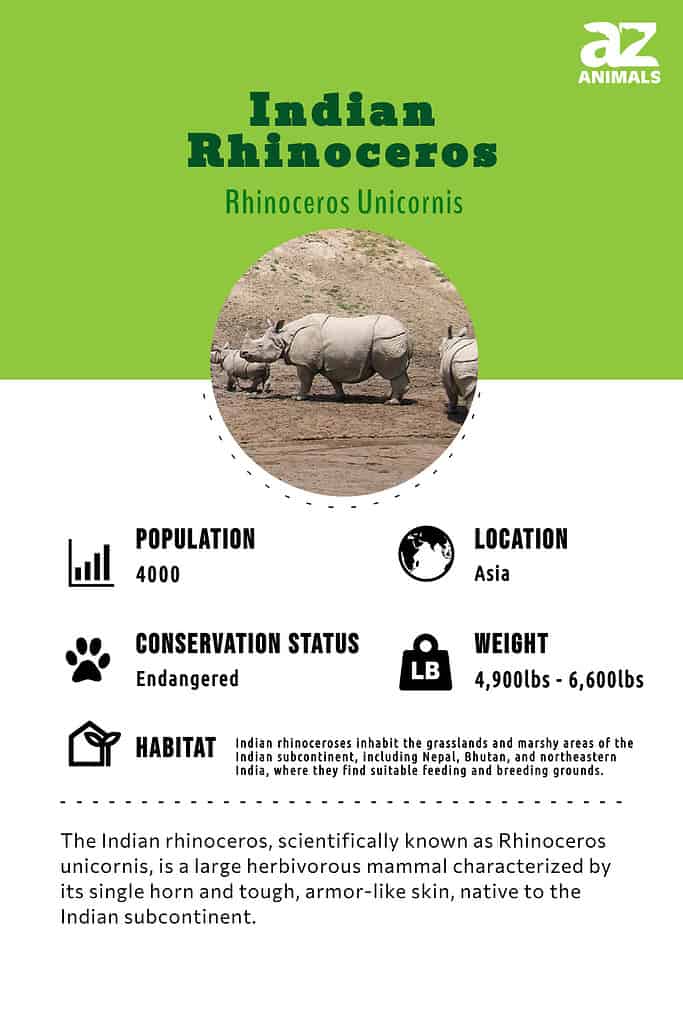
This one-horned ‘armored unicorn’ once roamed across India and Nepal, but today is rebounding from near extinction.
The Indian rhinoceros (also known as the greater one-horned rhinoceros and the Asian one-horned rhinoceros) is a species of rhinoceros native to parts of India and Nepal.
Although the Indian rhinoceros is still under threat today, its numbers have rebounded to the point it’s no longer endangered.
Incredible Indian Rhino Facts!
- Once numbering fewer than 100 individuals, today the great one-horned rhinoceros has seen its population rebound to the point it’s no longer endangered but listed as ‘Vulnerable.’
- Also known as the greater one-horned rhinoceros, the Indian rhino is the largest rhinoceros species in Asia and can weigh up to 3,000 kg (6,600 lbs)!
- The Indian rhino was brought to Europe during the Renaissance in 1515! The artwork of the animal was mass-produced across Europe and has been hailed as “the most influential animal picture ever.”
Scientific Name

The Indian rhinoceros is scientifically referred to as Rhinoceros unicornis.
©iStock.com/Stefan Rotter
The scientific name for the Indian rhinoceros is Rhinoceros unicornis. The genus Rhinoceros is Greek for ‘nose’ and ‘horn’ and comprises the two species of one-horned rhinos, the Indian and Javan rhinoceros. Unicornis is Latin and means one-horned.
Evolution and Origins
Rhinos first emerged in North America approximately 55-50 million years ago, and they were widespread in Florida until their extinction around 5 million years ago; the fossil remains of the extinct Floridaceras white have been found in both Florida and Panama.
Hyrachyus eximus, discovered in North America and dating back to the Early Eocene, is the earliest recorded mammal resembling a rhinoceros; this small creature resembled early tapirs and horses but did not possess a horn.
Approximately 55-60 million years ago, the rhinoceros family branched off from the tapir family, leading to the evolution of more than a hundred species that spread across different regions of the world, but only nine of them managed to survive until the Late Pleistocene era, which occurred between 14,000 and 12,000 years ago.
Appearance
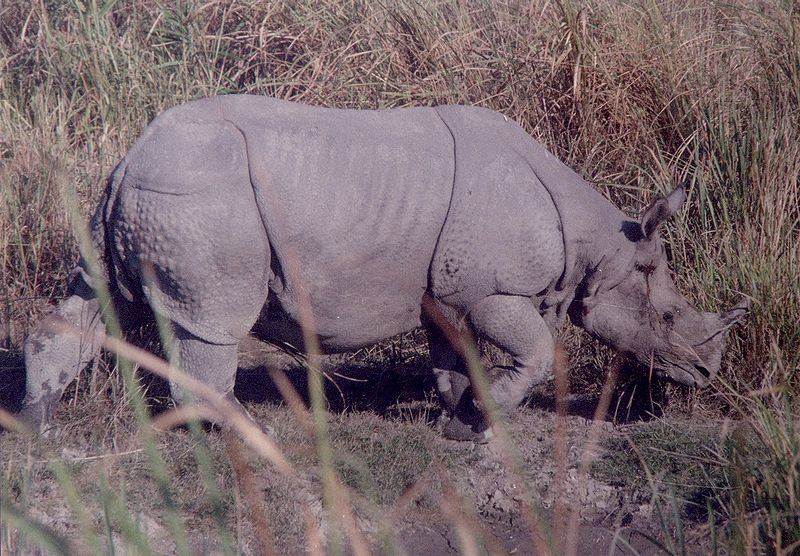
After the white rhino, the Indian rhino holds the distinction of being the second-largest rhinoceros species, with a weight ranging from 2,200 to 3,000 kg (4,900 to 6,600 lbs) and a height at the shoulders of 1.7 to 2 meters (5.6 to 6.6 ft).
The Indian rhino is the second largest rhinoceros species after the white rhino, weighing 2,200 to 3,000 kg (4,900 to 6,600 lbs). At its shoulders, it stands 1.7 to 2 meters (5.6 to 6.6 ft).
All rhino species have thick skin that forms a natural “armor” across their bodies, but the skin of the Indian rhinoceros has a unique appearance where flexible skin folds give the look of armor plates across its body.
In addition, the Indian rhino has distinctive bumps that can cover its legs, shoulders, and hindquarters.
Greater one-horned rhinoceros
A common name for the Indian rhino is the ‘greater one-horned rhinoceros.’ In historic times, the range of the Indian rhinoceros overlapped with a subspecies of the Javan rhinoceros, a species of rhino that also has one horn but is smaller than the Indian rhinoceros. Thus, the Javan rhino was often distinguished as the ‘lesser one-horned rhinoceros.’
Today, the Javan rhino subspecies that used to live across parts of India and Southeast Asia is extinct (although Javan rhinos still survive in Indonesia), but the name ‘greater one-horned rhinoceros’ is still commonly used for Indian rhinos.
The Indian rhino’s horn is generally less than a foot (30 cm) in length, although it has reached record sizes of up to 23 inches (57 cm).
Habitat
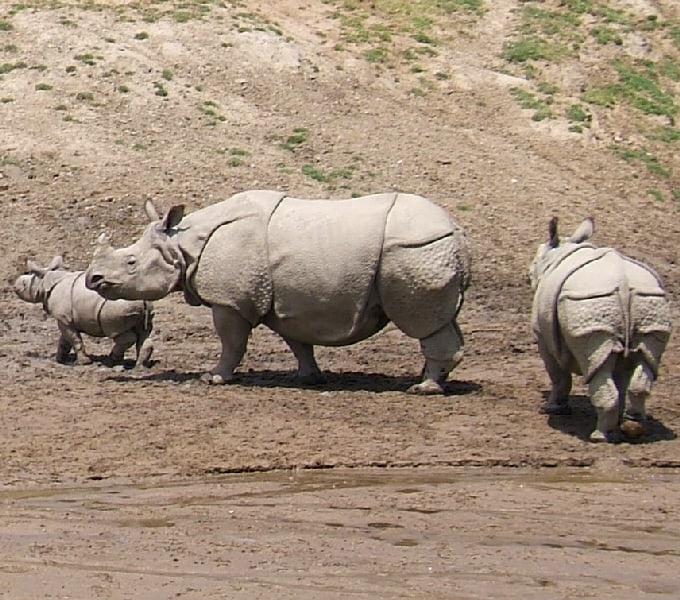
After the white rhino, the Indian rhino holds the distinction of being the second-largest rhinoceros species, with a weight ranging from 2,200 to 3,000 kg (4,900 to 6,600 lbs) and a height at the shoulders of 1.7 to 2 meters (5.6 to 6.6 ft).
Historically, the Indian rhinoceros had a vast range across northern India but today that range has been drastically reduced due to excessive hunting. The Indian rhinoceros is now confined to the tall grasslands and forests that surround the Himalayas Mountain range.
Grasslands the Indian rhino live in include the Terai-Duar grasslands, which are among the tallest in the world. The region’s ‘elephant grass’ can reach up to 22 ft (7 m), tall enough to provide cover even for a species the Indian rhino’s size.
Population: How Many of Them Are Left?
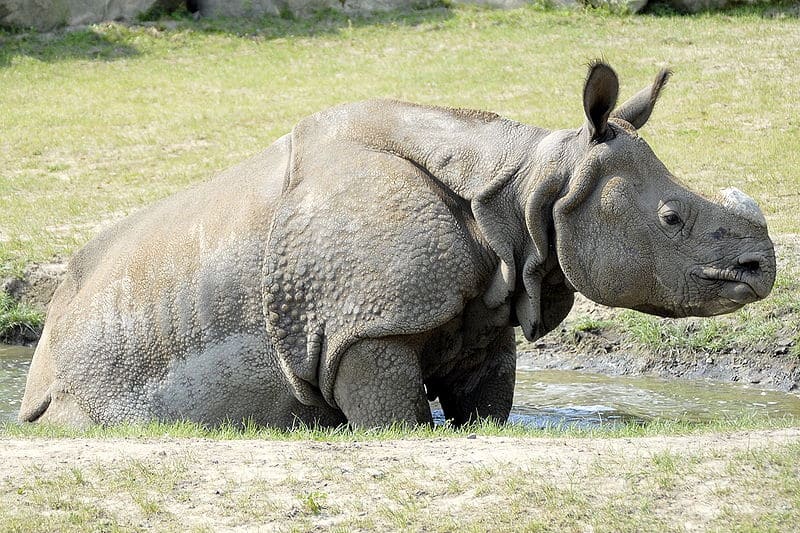
At the start of the 20th century, the population of Indian rhinos was believed to be fewer than 100 individuals remaining.
It’s estimated that fewer than 100 Indian rhinos were left at the beginning of the 20th century. Across the 20th century, populations rebounded, and as of 2019, an estimated 3,600 individuals live in the wild.
The rebound in Indian rhino populations has been strong enough that as of 2008, the species is no longer listed as Endangered. Instead, Indian rhinos are listed as Vulnerable despite having a lower population than the Critically Endangered black rhinoceros.
Despite its increasing population, Indian rhinos continue to face several threats. For example, the majority of Indian rhinos – 2,413 individuals as of 2018 – live in India’s Kaziranga National Park.
This concentration means a disease could take a significant toll on this concentrated population.
Diet
The Indian rhino lives across a fertile plain that has abundant tall grass it consumes for the majority of its diet. Indian rhinos are herbivorous animals, and in addition to grass will also browse the densely vegetated sub-tropical forest for leaves, flowers, buds, fruits, berries, and roots which they dig up from the ground using their horns.
Predators
Due to its large size, the Indian rhino’s only real predators in the wild are large wild cats such as tigers that will prey on the Indian rhino calves and weak individuals. Humans are the biggest threat to the Indian rhinoceros as they have been hunted to the brink of extinction for their horns.
Reproduction and Life Cycles

An Indian rhinoceros, at the Cincinnati Zoo
©FisherQueen – Public Domain
The Indian rhinoceros is a solitary animal and only comes together with other Indian rhinos to mate. The female Indian rhinoceros gives birth to a single calf after a gestation period that is over a year-long (about 15-16 months). The Indian rhinoceros calf remains with its mother until it is at least 2 years old and big enough to become independent.
Zoos
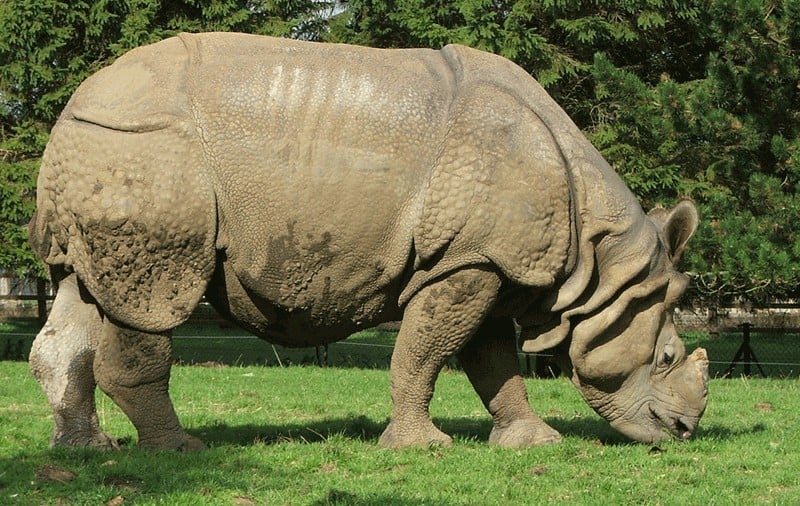
Indian Rhinoceros at Whipsnade Zoo
As of 2018, 67 zoos were home to 182 Indian rhinos. In total, there are 1,037 different rhinos of different species across the world’s zoos.
Select zoos where you can see an Indian rhino in person!
- Zoo Miami: Welcomed a new Indian rhino calf on May 1, 2019.
- Cincinnati: Once home to the Sumatran rhino, today the Cincinnati Zoo houses an Indian rhino named ‘Manjula.’
- San Diego Safari Park: Welcomed a calf Indian rhino to its Savanna field exhibit in August 2019.
Indian Rhino Facts
- Durer’s Rhinoceros
- In 1515 an Indian rhinoceros was sent to the King of Portugal in Lisbon. The exotic animal was shocking at the time, and a woodcut created by a German painter went on to be mass-produced across Europe. Unfortunately, the Indian rhino soon thereafter drowned, when a boat bringing it to the Pope was lost at sea.
- How do you count Indian rhinos? On the backs of elephants!
- Two-thirds of Indian rhinos live in Kaziranga National Park. Every three years a census is conducted to see if the population of Indian rhinos in this vital park continues to grow. To count the rhinos, officials rode 40 elephants in addition to sports vehicles.
- Poaching remains a threat, but…
- While poaching remains a threat, in 2015 Kaziranga National Park guards shot dead more would-be poachers than rhinos were shot. The relative protection from poaching is one of the reasons Indian rhinos are no longer listed as Endangered.
- While poaching remains a threat, in 2015 Kaziranga National Park guards shot dead more would-be poachers than rhinos were shot. The relative protection from poaching is one of the reasons Indian rhinos are no longer listed as Endangered.
Indian Rhinoceros FAQs (Frequently Asked Questions)
Is the Indian rhino extinct in India?
No, the Indian rhino today lives in both India and Nepal. Historically, the Sumatran rhino and Javan rhino also lived in India, but the subspecies of both animals that once lived in India are extinct today.
Is the Indian rhino Endangered?
Not anymore. While the Indian rhino has a lower population than the black rhino, which is listed as “Critically Endangered,” the Indian rhino today is listed as “Vulnerable.”
A big reason for the Indian rhinos population is the much more limited poaching of the species which has allowed its number to rebound for a sustained period.
Are Indian Rhinoceroses herbivores, carnivores, or omnivores?
Indian Rhinoceroses are Herbivores, meaning they eat plants.
What Kingdom do Indian Rhinoceroses belong to?
Indian Rhinoceroses belong to the Kingdom Animalia.
What phylum do Indian Rhinoceroses belong to?
Indian Rhinoceroses belong to the phylum Chordata.
What class do Indian Rhinoceroses belong to?
Indian Rhinoceroses belong to the class Mammalia.
What family do Indian Rhinoceroses belong to?
Indian Rhinoceroses belong to the family Rhinocerotidae.
What order do Indian Rhinoceroses belong to?
Indian Rhinoceroses belong to the order Perissodactyla.
What genus do Indian Rhinoceroses belong to?
Indian Rhinoceroses belong to the genus Rhinoceros.
What type of covering do Indian Rhinoceroses have?
Indian Rhinoceroses are covered in Leathery skin.
In what type of habitat do Indian Rhinoceroses live?
Indian Rhinoceroses live in tropical bushland, grasslands, and savannas.
What do Indian Rhinoceroses eat?
Indian Rhinoceroses eat grass, fruit, berries, and leaves.
What are some predators of Indian Rhinoceroses?
Predators of Indian Rhinoceroses include humans and wild cats.
How many babies do Indian Rhinoceroses have?
The average number of babies an Indian Rhinoceros has is 1.
What is an interesting fact about Indian Rhinoceroses?
The Indian Rhinoceros is also known as the one-horned rhino!
What is the scientific name for the Indian Rhinoceros?
The scientific name for the Indian Rhinoceros is Rhinoceros Unicornis.
What is the lifespan of an Indian Rhinoceros?
Indian Rhinoceroses can live for 45 to 50 years.
How fast is an Indian Rhinoceros?
An Indian Rhinoceros can travel at speeds of up to 30 miles per hour.
Thank you for reading! Have some feedback for us? Contact the AZ Animals editorial team.
Sources
- David Burnie, Dorling Kindersley (2011) Animal, The Definitive Visual Guide To The World's Wildlife
- Tom Jackson, Lorenz Books (2007) The World Encyclopedia Of Animals
- David Burnie, Kingfisher (2011) The Kingfisher Animal Encyclopedia
- Richard Mackay, University of California Press (2009) The Atlas Of Endangered Species
- David Burnie, Dorling Kindersley (2008) Illustrated Encyclopedia Of Animals
- Dorling Kindersley (2006) Dorling Kindersley Encyclopedia Of Animals
- David W. Macdonald, Oxford University Press (2010) The Encyclopedia Of Mammals

















